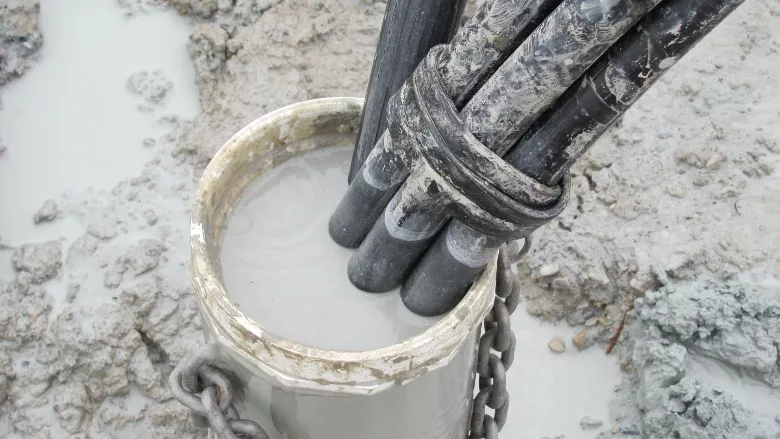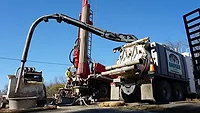4 Production Drilling Lessons from Ball State’s Geothermal Project
Big Job Shows Mindset Shift from Water Wells to Production

The Driller contributing writer Brock Yordy was mud engineer just starting out when he joined a team working the massive Ball State University geothermal project, which began in 2009. Work took place on an active college campus.
Source: Brock Yordy

The Triton Drilling teams drilled their first five holes and used knowledge gained there to get their drilling program in order for the 573 holes on their part of the project.
Source: Brock Yordy

Drilling was only half the battle. Installing the loops required a careful calibration of fluid density and weights to keep things on track.
Source: Brock Yordy
The demand for drilling companies capable of production drilling has climbed an all-time high. From East Coast to West Coast, you hear the same, significant theme at conventions: How do we to recruit water well drillers into production drilling for geothermal and other industrial applications?
As a young mud engineer at the beginning of my career, I had the opportunity to work and collaborate with a team of water well drilling companies from central Indiana. Ortman Drilling, Moss Well Drilling, and Dilden Bros. Well Drilling joined to create Triton Geothermal. Together they drilled the south field of Phase 1 for Ball State University’s 2009 geothermal project. That year, it was one of the largest ground-source heat loop projects in the United States. Phase 1 consisted of roughly 1,800 holes, with the south field alone totaling 573 holes. I recently reread my field notebook from 12 years ago, and it made me smile to think about all the great lessons learned with the team at Triton.
Lesson One: Understanding the Unknown
One of the greatest lessons I took away is, when tackling a large production drilling project, to utilize the first five holes to dial in the drilling program. It starts with the first hole, taking time to understand the transitions from overburden to the different geology layers from zero to total depth. At Ball State, the top 80 to 100 feet was a mix of sand, gravel, some clay and cobles. At 80 to 100 feet, it transitioned to broken limestone with shale seams to the bottom. Triton and I took time drilling the first few holes trying different drilling fluid combinations to stabilize the top unconsolidated formation, and slowly changing fluid mixes to drill limestone and reactive shales for 300 additional feet.
We determined that a single bit and one universal drilling fluid style would prove neither productive nor profitable for completing these holes. Therefore, we designed our drilling program in two parts. The first part involved drilling the unconsolidated zone on each hole with a traditional tricone and drilling fluid designed for both filtration control and stabilization of a porous formation with cobbles. Next, the team would trip out, set casing to the limestone, and trip in with a PDC bit to drill limestone and shale efficiently. For this part of each hole, we changed the drilling fluid mix to one that inhibited reactive shales and could lift limestone chips from a total depth of 400 feet.
Lesson Two: The Little Details
Beyond understanding the geology and the first five holes, we had to consider the multiple types of rigs Triton was operating and how that affected hole completion. The team was using a Versa Drill, a T2 Atlas Copco (at the time) and a 1980 Speedstar 15 table-drive. Each rig had different rotation speeds and methods for increasing pulldown. In addition, the different rig capabilities and even the different drillers on the platform caused fluctuations in bit life and drilling fluids consumption.
We found it essential to document how each rig and hole utilized consumables. For example, the Speedstar’s rotation speed decreased the number of holes a PDC bit would last. At the same time, that rig’s rotation speed created larger drill cuttings. This allowed for a cleaner drilling fluid that required less new bentonite and polymers to maintain its qualities. Conversely, the two top-drive rigs could maintain longer bit life but required much more frequent rebuilding of the drilling fluids.
Lesson Three: Drilling is Only 50% of Completion
After understanding how the drillers and rigs interacted with the downhole conditions from top to bottom, we took time to focus on the physics of installing two loops with clips in one hole. The original specification of the project required two 1-inch loops, but also clips that would spread the loops apart. The goal was to force the loops closer to the borehole wall, allowing for enhanced conductivity.
In production geothermal drilling, the hole is only half the battle. The second half is installing the loop with tremie and grouting to the surface. Heat Loops, just like PVC casing and screen, have a degree of buoyancy, which changes with the density of the drilling fluid in the hole. Standard practice usually involves maintaining a fluid density under 9.5 pounds per gallon, filling the loops with water and adding steel weight to overcome the buoyancy. However, we found installing two loops akin to pushing a pontoon boat down the hole.
The team utilized Mud Puppy solid control units and regular drilling fluid testing/rebuilding to maintain a fluid density below 9 pounds per gallon. However, even with a 9.0 mud weight, we required additional steel weight to overcome the floating of the loops. Two loops going into one hole require even the best drillers to methodically control all parameters — from the drilling phase to how loops are set to go in the hole.
Lesson Four: Production Drilling is More than just 1,000 Feet a Day
Once the Triton team had complete ownership over lessons one through three, they could focus on lesson four: production drilling. The key to staying on schedule and profitable is maintaining a consistent trend of multiple wells completed in any given day or week. The industrial drilling industry loves to pull trends from the oil and gas industry. One such trend I regularly encounter in geothermal production drilling is the idea you can only achieve greatness and profitability when a rig drills a minimum of 1,000 feet a day. Unfortunately, it isn’t about meeting or exceeding 1,000 feet a day. We, as an industry, misinterpreted the intent, which isn’t about footage. It’s about setting an achievable milestone that you can meet consistently, every day and week. That consistency virtually ensures that, at the end of the month, the amount of days drilling reflect a profitable return on investment.
Once you achieve your rig’s goal, focus the remainder of your time on maintenance and prep for the next 1,000 feet drilled tomorrow. This type of planning, preparation and maintenance allows for success week after week.
I know what you are thinking. “Brock, I can get 4,000 feet in by Wednesday afternoon, then coast the rest of the week and leave early on Friday.” I would tell you to check that driller ego and understand that achieving greatness isn’t about one rig hitting its goal, but all rigs onsite drilling their goal for the week. Once you achieve your rig’s goal, focus the remainder of your time on maintenance and prep for the next 1,000 feet drilled tomorrow. This type of planning, preparation and maintenance allows for success week after week. After maintenance and prep, help fellow crews. The team at Triton Geothermal understood the importance of executing consistently, maintaining their equipment and assisting other rigs when required, which made a massive impact on a successful outcome.
The mindset required to transition from water well to production driller is not easy. We believe drilling water wells is fun because we regularly drill new locations with new unknowns and challenges. I often hear drillers say, “There are no challenges to production drilling. Once you figure out the holes, you just pull levers until it’s over.” However, there are many challenges in production drilling, with one of the most significant ones being preventing the team from getting bored and complacent. Bad situations happen when a crew becomes complacent on any jobsite.
Ironically, I found it kind of like playing chess to complete over 500 holes 15 feet apart while maintaining a schedule that involved other contractors completing their own work (and working on an active college campus). There are many ways to win and some wins look more elegant. Apply these lessons for a little more elegance on your next industrial drilling project.
Looking for a reprint of this article?
From high-res PDFs to custom plaques, order your copy today!




